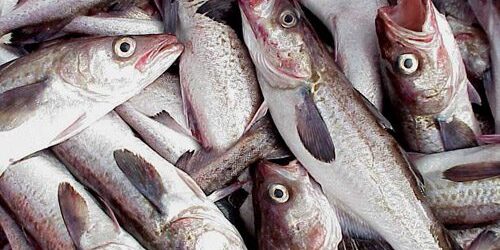After days of scientific subcommittees, the North Pacific Fishery Management Council had its first round of meetings Wednesday, hearing reports from fisheries across the North Pacific.
When it comes to Bering Sea pollock, catches remain flat. Glenn Merrill, an Assistant Regional Administrator for the Council, said this year’s catch is “almost identical to what it was last year at this time.”
But the Chinook bycatch within the pollock fishery is higher than last year’s rates—a major issue as subsistence fishermen along the Yukon and Kuskokwim rivers face unprecedented restrictions in anticipation of one of the worst king salmon runs on record.
Merrill reported, “The total Chinook salmon bycatch last year at this time last year was 8,237 fish. And the current Chinook salmon bycatch is 11,536. The rates are slightly higher this year for that same metric tonnage.”
Merrill also said, halibut bycatch is also higher—by about 12-percent—this year.
On the Russian side of the Strait, pollock fisheries are in full swing as well. Coast Guard Capt. Phillip Thorne said the Russian pollock fishery opened on May 15 of this year. Seven vessels are operating within 20 nautical miles of the maritime boundary line. Thorne said the Coast Guard patrolled the line May 29 through 31 and is continuing to send out patrol ships and aircraft as the season progresses.
As for other species in the Bering Sea, snow crab were slightly down. Karla Bush with the Alaska Department of Fish and Game said the season ended about two weeks earlier than it had in the past.
When the floor opened for public comment, representatives from At-Sea Processors Association, United States Seafood, and Glacier Fish Company asked the Council to reapportion 100 metric tons of halibut bycatch for this year. The representatives said the measure would help “maximize” catches of yellowfin sole and cod. The representatives said fisheries could enter a voluntary agreement to capture 60-percent of the reapportion and leave 40-percent in the water for future savings. The Council said it will examine this request on Saturday at 1:00 pm.
Helping to help reduce that salmon bycatch by pollock fishermen, at another meeting in Nome the fishery council’s scientific and statistical committee heard about an experimental fishing net that could soon be deployed in the Bering Sea.
On Wednesday the committee heard the results of a study using nets designed to increase salmon escapement numbers on pollock trawlers. The experimental nets, called “over-under” nets, were tested in the Gulf of Alaska. Trials could begin next year in the Bering Sea.
“The testing involves three different seasons starting in 2015,” said John Gauvin, a researcher designing the nets as well as the experiments for the North Pacific Fisheries Research Center. “We’re hopeful that the results we got in the Gulf of Alaska, which were encouraging in terms of Chinook salmon escapement at levels of 40 percent, we’re hoping to do as well or better than that in the Bering Sea.”
Addressing the science committee, Gauvin said the goal of testing in the Bering Sea is to see if the nets can be scaled up.
“So why do we need to do this in the Bering Sea?” he asked rhetorically.
“Well, these boats have greater horsepower, they tow faster, more towing force and net spread,” he said. “Also we’ve done no testing on chum salmon in the Gulf—it’s just not an issue there. Earlier, earlier, earlier version of this in the Bering Sea, in the last part of the Bering Sea testing we got 20 percent escapement, we think on chums in the Bering Sea we might be able to do better than that.”
Over-under nets are just one tool in the toolbox researchers and commercial fishermen are using to improve escapement numbers and reduce salmon bycatch.
But while the new nets could increase escapement from around three percent to as much as 40 percent, that still means six of every ten Chinook salmon caught in pollock nets stay there. And for groups like the Association of Village Council Presidents in the Yukon-Kuskokwim Delta, those numbers are still much to high at a time when Chinooks are off-limits for subsistence users.
The Science and Statistical Committee said it’s likely to recommend the Bering Sea trial move forward.
KNOM’s Zachariah Hughes contributed to this story.






